

| Click on a book's image or title to order from Amazon.com |

The Tribe of Tiger: Cats and their Culture
by Elizabeth Marshall ThomasSimon & Schuster, © 1994, ISBN #0-671-79965-7
I live with two cats, and I frequently am at a loss trying to figure out how they behave why they do. Thomas has written this very nice book which helps fill in some holes.
The book is divided into three parts. The first part discusses the evolution of cats and some general principles regarding their behavior. Unlike dogs and bears, cats are almost exclusively meat-eaters; they might nibble on some other food, but meat is their sustenance. This means that their whole life is organized around hunting, and this goes a long way towards explaining them. But there's a lot more to it, as well: Cats are highly competitive, fight and kill each other for territory, and are infanticidal by nature. While cats live in a hierarchical structure, it turns out that other than the top cat there may be several cats on the same rung of the "ladder".
It also appears that housecats sometimes accord humans some special status. While I have friends who can say that one of their cats is definitely the "top cat", my two cats appear to be equals. I've finally decided that they think that I am the top cat - which appears to be what happened in Thomas' household for a while, as well.
The evolution of cats and their ecosystem is also rather interesting: Many cats are hunt-and-stalk types, such as pumas. A few, like cheetahs, run their prey into the ground and don't need camouflage. And most cats are social: Lions are most obviously so, but tigers tend to live in groups too, albeit groups where the individuals are spread out by hundreds of feet. But they still know that the others are around. It also appears that lions are more recently evolved than man - about 700,000 years old.
The second part of the book is largely a collection of anecdotes involving Thomas' experiences in Africa with lions. She was familiar with the lions and the bushmen of the region and watched the two groups interact in the 1950s. And she was able to return more recently when the bushmen had largely been driven from their land, and the lions' habitat was also being taken over. Lions are adapting bit-by-bit to the intrusion of "modern" man, though their relationship to the men is very different - and a lot more hostile - than their relationship with the bushmen was.
The third part discusses in more detail how many cats are dealing with modern society. Tigers are not faring so well, in large part because they are specifically hunted for their coats and as "resources" for oriental "medicine". She discusses how zoos tend to be awful places for tigers, because they canUt hide, and they can't interact properly with each other, and it's just tremendously boring. At the same time, she says that tigers might have already died out if not for the artificial breeding programs promulgated by zoos. She says that circus tigers tend to have much better lives: People who care for and about them, other tigers to interact with, and a challenging and exciting job to perform.
By contrast, the puma seems to be doing quite well, much to the surprise of some. Apparently the puma was thought to be dying out not long ago, but in fact pumas are thriving out west (e.g., in Colorado), and are even returning to the east coast; there is even some reason to believe that pumas never were driving out of the northeast, but that they became especially adept at avoiding man and have been there all along.
It's an interesting book on many different levels, and if you like cats, I highly recommend it.
hits since 13 August 2000.